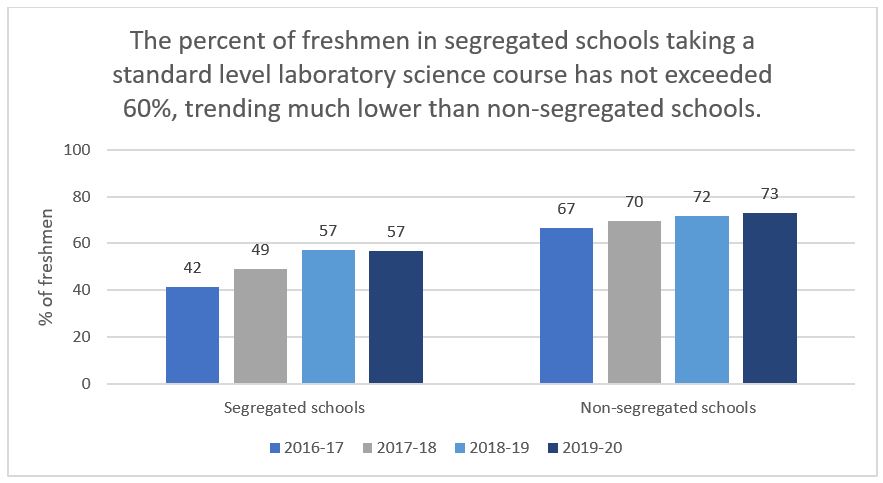Vandeen Campbell, Ph.D.
It is well established that careers in science, technology, engineering, and mathematics (STEM) fields tend to offer higher wages (Carnevale, Cheah, & Hanson, 2015). Further, individuals who begin engaging in standard and advanced STEM coursework early in high school are more likely to pursue STEM majors in college (Enberg & Wolniak, 2013). NJ’s high school graduation criteria requires 15 credits (about 3 full-year courses) of laboratory and inquiry-based science coursework, but there are potholes that could put students at a disadvantage. A subtle issue is that, while students may meet the graduation requirement, they may not have taken a combination of science courses valued in the admissions process (usually Biology-Chemistry-Physics) at higher-tiered colleges or that would allow them to pursue STEM majors at competitive schools. Further, as advantageous as STEM careers are known to be, there are wide disparities in STEM -relevant participation by race, gender, and socioeconomic status (Tyson et al., 2007). The Joseph C. Cornwall Center for Metropolitan Studies is conducting research to shed light on issues impacting equity in access to education.
Key to this inquiry is investigating whether students in different high schools have the opportunity to participate in science courses at higher academic levels. A body of research from the 1990s to the early 2000s studied the distribution of science course-taking across the nation and classified science course taking pipelines (Burkham & Lee, 2003; Teitlebaum, 2003). The course pipeline measures are useful in classifying courses as lower-level/remedial; lower-level introductory; standard secondary-level; and advanced. Standard secondary-level academic courses, which students could take include General Biology I in the life science pipeline and Chemistry I and Physics I in the physical science pipeline (Burkham & Lee, 2003). Lower-level or introductory science courses might include Basic Biology (life science pipeline) and Environmental Science (physical science pipeline). In general, while content may be interesting, not all courses offered in high school reach the level of a standard or advanced secondary course.
For NJ high schools, differences in science course-taking trends emerge at the outset in freshman year between schools considered to be segregated (here, 90%+ students of color and 50%+ economically disadvantaged) and those which are not segregated. Greater proportions of freshmen in segregated schools take lower-level secondary science courses, mainly Environmental Science, compared to those in non-segregated schools.
Source: Author’s calculations based on data from NJ Department of Education (NJDOE) School Performance Reports. Standard-level laboratory science includes the combined percentages of freshmen taking Biology, Chemistry, and Physics. Note that, based on the NJDOE data documentation, students taking more than one of these courses would have been counted in each course taken.
Up until the 2017-2018 school year, roughly one-third of freshmen in segregated schools took Environmental Science, a lower-level, introductory secondary science course based on the Burkham & Lee (2003) physical science pipeline. During that time, less than a third of freshmen in segregated schools took Biology, a standard secondary course typically taken freshman year (i.e., the first pillar in the Biology-Physics-Chemistry series favored by higher tiered colleges). While increasing proportions of freshmen in segregated schools took a standard laboratory science course from 2016-2017 (about 42%) to 2019-2020 (57%), it remains much lower than for non-segregated schools (where taking such courses increased from 67% to 73%). As a result, the gap between the segregated and non-segregated schools decreased from 25 percentage points in 2016-17 to 16 percentage points in 2019-20.
Although these aggregate data are limited in helping us draw conclusions about the precise course-taking trends and quality of the courses being taken, the fact that students in segregated schools are much less likely to be enrolled in a standard secondary-level laboratory science course freshman year signals an area of potential disparity worth monitoring. Science course-taking trends throughout the high school trajectory in NJ are discussed in the full report we are developing with funding from the New Jersey State Policy Lab (forthcoming March 2022) and further differences are apparent.
References
Burkam, D. T., & Lee, V. E. (2003). Mathematics, foreign language, and science coursetaking and the NELS:88 transcript data (NCES 2003–01). Washington, DC: U.S. Department of Education, National Center for Education Statistics.
Carnevale. A. P., Cheah, B., & Hanson, A. R. (2015). The economic value of academic majors. Georgetown University, Center on Education and the Workforce. Retrieved from https://cew.georgetown.edu/cew-reports/valueofcollegemajors/#resources.
Enberg, M. E. & Wolniak, G. C. (2013, January). College student pathways to the STEM Disciplines.
Teachers College Record 115, 1-27.
Teitlebaum, P. (2003, Spring). The influence of high school graduation requirement policies in mathematics and science on student course-taking patterns and achievement. Educational Evaluation and Policy Analysis, 25(1), 31-57.
Tyson, W., Lee, R., Borman, K. M., & Hanson, M.A. (2007). Science, technology, engineering, and mathematics (STEM) pathways: High school science and math coursework and postsecondary degree attainment. Journal of Education for Students Placed at Risk (JESPAR), 12(3), 243-270.


